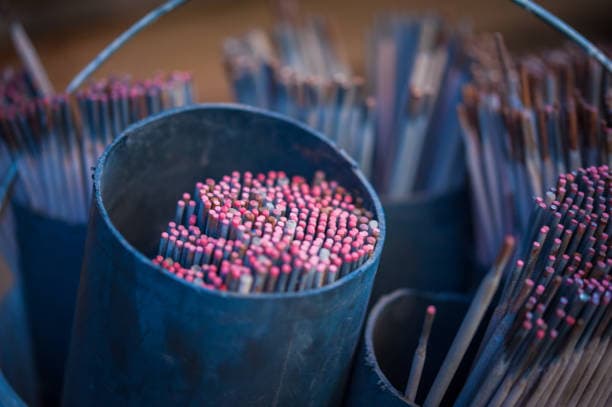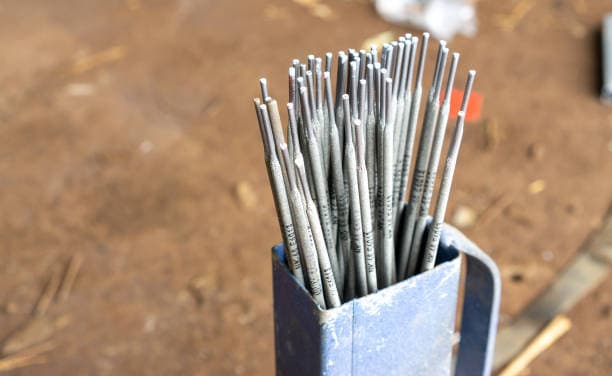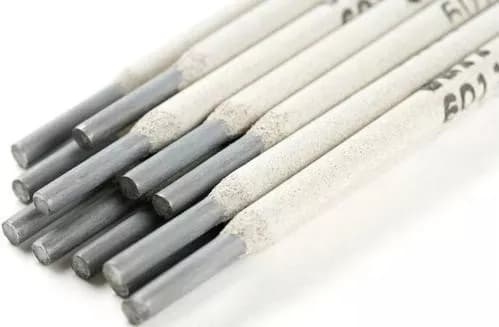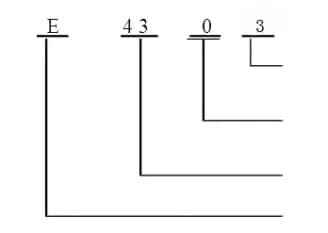I'm sure you all know that welding rods are an essential component for electric welding.
Once the welding rods are connected, the welding tongs can begin their operation.
However, do you know which model of welding rod you are using?

The use of welding rods is very specific.
Incorrect use of welding rods can compromise welding strength, which is why it must be welded again with suitable material.
In the case of large parts, incorrect use of welding rods can result in cracks at the welding site, posing a threat to life and property.
Therefore, it is important to understand the electrode composition.

- Final fixing
- Electrode Coating
- Welding Core
- Impressive end of the arc
The electrode is coated with a special material called electrode coating.
This type of electrode, known as a shielded metal arc welding electrode, consists of two parts: the coating and the welding core.
The metal wire covered by the electrode coating is called the welding core.
Typically, the welding core is made of steel and has a specific length and diameter.

Function of welding core
The welding core has two main functions:
- It conducts the welding current and generates an electric arc, converting electrical energy into thermal energy.
- The welding core itself melts and becomes the filler metal, fusing with the liquid base metal to form the weld.
When welding with electrodes, a portion of the weld metal comes from the core metal.
As a result, the chemical composition of the welding core significantly impacts weld quality.
For this reason, the steel wire used as a welding core must have a specific brand and composition.
When other fusion welding methods such as automatic submerged arc welding, electroslag welding, gas shielded welding or gas welding are used as filler metal, they are called welding wires.
Related Reading: Types of Welding
The electrode coating is the layer applied to the surface of the welding core.
During the welding process, the coating decomposes and melts producing gases and slag, providing mechanical protection, metallurgical treatment and better process performance.
The composition of the coating includes minerals (such as marble and fluorspar), ferroalloys and metal powders (such as ferromanganese and ferrotitanium), organic substances (such as wood flour and starch) and chemical products (such as titanium dioxide and sodium silicate). .
The quality of the electrode coating is a crucial factor in determining the quality of the weld.

Role in the welding process:
1. Improve arc combustion stability
A bare, uncoated welding rod is difficult to strike an arc with.
Even if an arc is established, it will not burn consistently.
2. Protect the welding pool
During the welding process, the immersion of oxygen, nitrogen and water vapor from the air into the weld can have negative impacts on the weld.
This can result in the formation of pores and a reduction in mechanical properties, and can even lead to cracking.
However, when the electrode coating is melted during welding, the large amount of gas produced covers the arc and the weld pool, reducing the interaction between the molten metal and the air.
After cooling, the molten coating forms a layer of slag on the surface of the weld, providing protection to the weld metal, slowing the cooling process and reducing the risk of air pockets.
3. Ensure deoxidation and removal of sulfur, phosphorus and impurities from welds
Despite the protective measures implemented during the welding process, a small amount of oxygen will inevitably enter the weld pool. This can lead to oxidation of the metal and alloy elements, burning of the alloy elements and decreased weld quality.
To counteract this, reducing agents such as manganese, silicon, titanium and aluminum are added to the electrode coating to reduce the oxides present in the molten pool.
4. Supplement of alloying elements for welds
The high temperature of the arc can cause vaporization and burning of the alloying elements of the weld metal, reducing its mechanical properties.
To compensate for this loss, appropriate alloying elements must be added to the weld through coating to maintain or improve the mechanical properties of the weld.
For welding certain types of alloy steels, it is also necessary to introduce the alloy into the weld through the coating, so that the composition of the weld metal is similar to that of the base metal and its mechanical properties match or even exceed those of the base metal. base. base metal.
5. Improve welding productivity and reduce spatter
The electrode coating has the added benefit of increasing droplet formation and reducing spatter.
The melting point of the electrode coating is slightly lower than that of the core, but because the core is in the center of the arc and has a high temperature, it melts first, followed by the coating.
This results in less metal loss due to spatter, better deposition coefficient and greater welding productivity.
So far, we have discussed the composition of welding rods. When choosing a welding rod, it is important to understand that there are different types of welding rods.
For example, let's consider a J422 electrode.

Do you see the number in the drawing?
J422 welding rod is a common name that corresponds to the international standard grade E4303.
It is an acidic welding rod with titanium and calcium coating.
The “J” in J422 represents a structural steel welding rod and “42” represents the tensile strength of the weld metal, which is 42kg/mm2.
The international standard grade E4303 can be explained as follows:

- E – electrode
- 43 – The tensile strength of the deposited metal is not less than 430Mpa.
- 0 – Represents that the welding position of the electrode is straight (“0” and “1” are suitable for welding in all positions, “2” are suitable for flat welding and flat fillet welding, and “4” are suitable for welding downward vertical welding).
- 3 – The combination of the third and fourth digit represents the type of welding and coating current
In simpler terms, the J422 welding rod used in China is equivalent to the E4303 welding rod used internationally.
Let's take some models as an example.
Comparison of common welding rod models and brands
| Model | Brand | Model | Brand |
| E4303 | J422 | E5003 | T502 |
| E4316 | J426 | E5015 | J507 |
| E5016 | J506 | E6016 | T606 |
| E6015 | J607 | E7015 | 3707 |
Here is a brief summary of the general selection criteria:
The brands of commonly used welding rods are established by the manufacturer or industry, and the models are widely recognized internationally, with a wide variety of types.
There are approximately 300 different types of welding rods.
Within the same type, different models are categorized based on their unique characteristics.
A specific type of welding rod may have one or several variations.
It is common for welding rods of the same type to have different markings on different welding rods.
Common welding rods mainly include:
(1) For low carbon steel structural parts, type E4303 (J422) or E5023 (J502) type calcium titanium welding rods are typically used.
(2) For important structural parts with high requirements for plasticity, toughness and crack resistance, E4315 (J427) or E5015 (J507) low hydrogen welding rods should be used.
When using an AC welding machine, E4316 (J426) or E5016 (J506) low hydrogen AC and DC welding rods can be chosen.
(3) For thin plate components that require a beautiful and smooth soldering surface, E4313 (J421) titanium welding rods are preferred.
(4) When welding components that cannot remove oil, rust and other dirt and require deep penetration, E4320 (J424) iron oxide welding rods are recommended.
(5) For components with many vertical welds, if conditions permit, special welding electrodes for vertical downward welding, such as E4300 (J420) welding rods, can be selected.
These are some of the common welding rods that are differentiated based on their intended use.
The diameter of the welding rod is determined by the thickness of the welding and is generally divided into 2, 2.5, 3.2, 4, 5, 6mm and other sizes for the core.
The most commonly used sizes are 2.5, 3.2 and 4 mm.
The approximate diameter and welding current are as follows:
| Diameter of welding rods (mm) |
Welding current (A) |
| 1.6 | 25-40 |
| two | 40~65 |
| 2.5 | 50~80 |
| 3.2 | 100~130 |
| 4 | 160~210 |
| 5 | 200~270 |
| 6 | 260~500 |
The electrode diameter selection method based on the welding thickness is as follows:
(1) If the welding thickness is less than or equal to 4 mm, the selected electrode diameter should not exceed the welding thickness.
(2) For welding with a thickness of 4mm to 12mm, the electrode diameter must be between 3mm and 4mm.
(3) If the welding thickness is more than 12mm, the diameter of the welding rod must be at least 4mm.
For example, structural steel is designated as “J XXX,” where “J” represents a structural steel welding rod and the third number represents the coating type and welding current requirements. The first and second numbers indicate the tensile strength of the weld metal.
J507
- J represents structural steel electrode;
- 50 represents that the tensile strength of the weld metal is not less than 490MPa;
- 7 means low hydrogen electrode coating, DC.
The type of welding rod is determined based on relevant national and international standards. For structural steel, the letter “E” designates the welding rod. The first and second digits indicate the minimum tensile strength of the deposited metal, while the third digit represents the welding position of the electrode. The third and fourth digits indicate the type of welding current and coating used.
E4315:
- E: Indicates welding rod;
- 43: Minimum tensile strength value of the deposited metal;
- 1: Indicating test welding and complete position;
- 5: Indicates that the electrode coating is low hydrogen and sodium type and DC reverse connection can be adopted;
Common structural steel electrodes include J421, J422, J423, J424, J506 and J507. For example, E43 series welding rods can be used to weld low carbon steels such as 20Mn and Q235 or steels with a tensile strength of approximately 400MPa. E50 series welding rods can be used to weld 16Mn, 16Mng and other steels with tensile strength ranging from 500MPa (1MPa is approximately equal to 10kg of force).
Here is an example.
Now let's take Q235 as an example and discuss how to choose 5mm thick steel. (Note: Answers to the following questions can be found in the article.)
Q235 is a low carbon steel with yield strength of 235 Mpa and tensile strength of 370-500 Mpa.
For this material, we can choose E43 series welding rods. As the part requirements are not demanding, we can use E430 or E431 for all-position welding.
Furthermore, low carbon steel is symbolized by 3 titanium-calcium type coatings.
For materials 5 mm thick, the recommended electrode diameter is 3.2 mm.
For welding rods with a diameter of 3.2mm, the recommended current is 100-130A.
In conclusion, we must use E4303 welding rods with a diameter of 3.2 mm and a current of approximately 110A to weld Q235 steel with a thickness of 5 mm.
For ease of use, I have provided a simple form to follow if you understand the information presented above.
Welding between the same metallic materials
| Steel Grade | garden | model | Comments |
|---|---|---|---|
| Q235,10,20 | J422 | E4303 | J422 is used for general structure, with complex shape and great rigidity. |
| J426 | E4316 | J426 and J427 are used for thick welding; | |
| J427 | E4315 | J426 and J427 are used for Q235-C and Q235D. | |
| 20R; 20g | J426 | E4316 | |
| J427 | E4315 | ||
| 16MnR | J502 | E5003 | Generally, the first three types of welding rods are selected. When the weld toughness requirements are high, the latter two types of welding rods can be selected. |
| J506 | E5016 | ||
| J507 | E5015 | ||
| J506R | E5016-G | ||
| J507R | E5015-G | ||
| 15MnVR | J506R | E5016-G | When the plate thickness is large, the first two welding rods can be selected. |
| J507R | E5015-G | ||
| J556 | E5516-G | ||
| J557 | E5515-G | ||
| 15MnVNR | J556 | E5516-G | Generally, the first three types of welding rods are selected. When the structural rigidity is small and the strength requirement is high, the last two types of welding rods can be selected. |
| J557 | E5515-G | ||
| J557MoV | E5515-G | ||
| J606 | E6016-D1 | ||
| J607 | E6015-D1 | ||
| 18MnMoNbR | J606 | E6016-D1 | Large rigid and thick plate structure can be used with ultra-low gas and high tenacity welding rod or Ni-containing welding rod; |
| J607 | E6015-D1 | Preheat 150~250℃ before welding and conduct post-250~350℃ heat treatment immediately after welding or when welding is stopped and conduct stress relief heat treatment after welding. | |
| J606RH | E6016-G | ||
| J607RH | E6015-G | ||
| J607Ni | E6015-G | ||
| 13MnNiMoNbR | J606 | E6016-D1 | Preheat 150 ~ 200 ℃ before welding, and conduct nitrogen elimination treatment at 350 ~ 400 ℃ after welding. |
| J607 | E6015-D1 | ||
| J607Ni | E6015-G | ||
| 07MnCrMoVR | J606RH | E6016-G | |
| J607RH | E6015-G | ||
| 15CrMoR 14CrMoR |
R302 | E5503-B2 | Preheat 160 ~ 200 ℃ before welding, and conduct 675 ~ 705 ℃ quenching treatment after welding. |
| R307 | E5515-B2 | R302 is mainly used for roof welding. | |
| 12Cr1MoV | R312 | E5503-B2-V | Preheat 250 ~ 300 ℃ before welding, and conduct 715 ~ 745 ℃ quenching treatment after welding. |
| R317 | E5515-B2-V | R312 is mainly used for roof welding. | |
| 12Cr2Mo1 | R402 | E6000-B3 | Preheat 160 ~ 200 ℃ before welding and 675 ~ 705 ℃ quenching treatment after welding. |
| R407 | E6015-B3 | R402 is mainly used for roof welding. | |
| 16MnDR | J506RH | E5016-G | Tempering at 600 ~ 650 ℃ after welding can reduce the brittle fracture tendency of low-temperature steel welding products, eliminating welding stress. |
| J507RH | E5015-G | ||
| J507NiTiB | E5015-G | ||
| W507 | E5015-G | ||
| 15MnNiDR 09MnNiDR |
W607 | E5015-G | |
| W607H | E5515-C1 | ||
| 09Mn2VDR 09MnTiCuReDR |
W707 | E5015-G | |
| W707Ni | E5515-C1 | ||
| OCr18Ni9 | A102 | E308-16 | |
| A102A | E308-17 | ||
| A107 | E308-15 | ||
| 00Cr19nl10 0Cr18Ni10Ti 0Cr18Ni11Nb 1Cr18Ni9Ti |
A002 | E308L-16 | |
| A002A | E308L-17 | ||
| A002Mo | E308MoL-16 | ||
| A132 | E347-16 | ||
| A132A | E347-17 | ||
| A137 | E347-15 | ||
| 0Cr17Ni12Mo2 | A202 | E316-16 | |
| A207 | E316-15 | ||
| A212 | E318-16 | ||
| 0Cr19Ni13Mo3 | A242 | E317-16 | |
| 0Cr18Ni12Mo2Ti | A212 | E318-16 | |
| 00Cr17Ni14Mo2 | A002 | E316L-16 | |
| A022L | |||
| 00Cr19Ni13Mo3 | A032 | E317MoCuL-16 | |
| 00Cr18Ni5Mo3Si2 | A022Si | E316L-16 | |
| 0Cr13 0Cr13A1 |
G202 | E410-16 | When the first three types of welding rods are used, the welding must be preheated to a temperature above 300°C and quenched and slowly cooled to 700℃ after welding. |
| G207 | E410-15 | ||
| G217 | E410-15 | ||
| A107 | E308-15 | ||
| A207 | E316-15 | ||
| A407 | E310-15 |
Welding rods are recommended for welding different types of steel
| Common Steel Grade | note | model |
|---|---|---|
| Q235-A+16Mn | J422 | E4303 |
| 20, 20R+16Mn, 16MnRC | J427 J507 | E4315 E5015 |
| Q235-A+18MnMoNbR | J427 J507 | E4315 E5015 |
| 16MnR+18MnMoNbR | J507 | E5015 |
| Q235A+15CrMo | J427 | E4315 |
| 16MnR+15CrMo,20, 20R, 16Mn+12Cr1MoV |
J507 | E5015 |
| Q235A+OCr18Ni10Ti 20R+0Cr18Ni10Ti 16MnR+0Cr18Ni10T |
A302 A307 A062 | E309-16 |
| E309-15 | ||
| E309L-16 | ||
| Q235A+0Cr17Ni12Mo2 20R+0Cr17Ni12Mo2 16MnR+0Cr17Ni12Mo2 |
A312 A317 A042 | E309M0-16 |
| E309M0-15 | ||
| E309MoL-16 | ||
| Q235A, 20R,16MnR+00Cr17Ni14Mo2 | A312 A317 A042 | E309M0-16 |
| E309M0-15 | ||
| E309MoE-16 |
























































